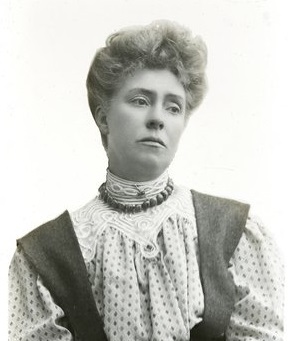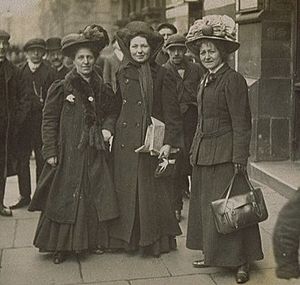Minnie Baldock facts for kids
Quick facts for kids
Minnie Baldock
|
|
|---|---|

Photograph of Minnie Baldock by Colonel L. Blathwayt, the father of Mary Blathwayt
|
|
| Born |
Lucy Minnie Rogers
20 November 1864 Bromley-by-Bow, England
|
| Died | 10 December 1954 Poole, Dorset, England
|
| Organization | Women's Social and Political Union, Church League for Women's Suffrage |
Lucy Minnie Baldock (born Rogers; November 20, 1864 – December 10, 1954) was a British suffragette. A suffragette was a woman who actively campaigned for the right to vote in elections. Minnie Baldock helped start the first London branch of the Women's Social and Political Union (WSPU) alongside Annie Kenney. This group worked hard to get women the right to vote.
Contents
Who Was Lucy Minnie Baldock?
Early Life and Fight for Change
Lucy Minnie Rogers was born in Bromley-by-Bow, England, in 1864. When she was young, she worked in a shirt factory where conditions were often tough. In 1888, she married Harry Baldock, and they had two children.
Minnie and her family lived in the East End of London, an area known for its challenging living conditions. They joined the Independent Labour Party (ILP) after a socialist leader named Keir Hardie became their local Member of Parliament in 1892. Minnie worked with other important figures like Charlotte Despard and Dora Montefiore. She even managed a local fund to help people facing extreme hardship.
At that time, women were not allowed to be Members of Parliament. However, the ILP chose Minnie as their candidate for a local council role, the West Ham Board of Guardians, in 1905.
Joining the Suffragette Movement
In 1906, Minnie Baldock and Annie Kenney started the first London branch of the Women's Social and Political Union (WSPU). This group, which began in Manchester, was dedicated to achieving voting rights for women. They held many meetings at the Canning Town Public Hall.
Minnie was very active in the movement. In December 1905, she attended a political meeting dressed as a maid to help Annie Kenney display a "Votes for Women" banner. They spoke out, causing a stir. The next day, Minnie and Annie visited a leading politician, Sir Henry Campbell-Bannerman, to ask about women's suffrage. Their brave actions were praised by others in the movement.
Speaking Out and Protesting
Minnie became a paid worker for the WSPU. She helped mentor new activists like Daisy Parsons. She traveled to different towns, like Long Eaton, to attend and organize meetings. Important speakers such as Emmeline Pethick-Lawrence, Annie Kenney, and Flora Drummond were invited to speak to the Canning Town group. Minnie also organized and spoke at outdoor meetings, including one in Upton Park.
On October 23, 1906, Minnie was arrested along with other suffragettes while protesting during the opening of Parliament. They were trying to make their voices heard about women's right to vote.
In 1907, Minnie visited Jane Sbarborough in Holloway Prison. She learned how suffragettes in prison would signal to each other since they weren't allowed to talk. Minnie also joined Christabel Pankhurst outside the prison to welcome other suffragettes who were being released. She spoke at several events, including a home event in Knightsbridge and another in Kensington with Emmeline Pankhurst. She believed it was important:
'to make the rich and idle women realise the difficulties that drive poor women to demand the vote'.
This meant she wanted everyone to understand why women from all backgrounds needed the right to vote.
In November 1907, Minnie was asked to leave a Liberal MP's event on the Isle of Dogs. Undeterred, she stood on a chair outside a window, calling out "Votes for Women!" In the summer of 1908, she helped build up the WSPU in Nottingham. She also attended a breakfast event in April 1909 to celebrate Mrs. Emmeline Pethick-Lawrence's release from custody.
Standing Up for Women's Rights
In February 1908, Minnie was among twelve women arrested while marching towards the House of Commons. They were with Mrs. Emmeline Pankhurst and wanted to deliver a petition from a conference. The authorities stopped them, and Minnie, Mrs. Pankhurst, and others were arrested for trying to continue their protest.
Minnie and Annie Kenney were fined for their actions. They were given a choice: pay the fine or go to prison for a month. Mrs. Pankhurst and others faced a similar choice, either pay a sum of money to promise good behavior or go to prison for six weeks. All these brave women chose to go to prison. They believed this was important to show how serious they were about getting the vote for women.
While Minnie was in prison for a month, her fellow suffragettes helped care for her two sons. Minnie managed to send a message from prison, which was published in Votes for Women in 1908. She wrote:
"I love freedom so dearly that I want all women to have it, and I will fight for it until they get it"
This shows her strong commitment to the cause.
Later that year, Minnie received an offer of help with house chores so she could dedicate more time to the suffrage movement. In May, she worked with Annie Kenney in Bristol to support Elsie Howey and Vera Holme in their efforts to attend a political event. In October 1909, Minnie was arrested again with Flora Drummond and the Pankhursts.
As a suffragette who had been to prison, Minnie was honored in February 1909 by planting a commemorative tree at Eagle House in Somerset. This house belonged to the parents of Mary Blathwayt, who supported the suffragette cause. The following year, Minnie spoke on Wimbledon Common and helped Mary Jane Clarke campaign in Brighton.
In 1911, Minnie joined other suffragettes in boycotting the national census as a form of protest. Later that year, Minnie was diagnosed with cancer and had surgery. After her recovery, she focused on her health and continued her work with other groups, including the Church League for Women's Suffrage. Around 1913, she and her family moved to Liverpool so her sons could find work in shipyards.
Minnie continued to honor the movement's leaders. She took part in Emmeline Pankhurst's funeral in 1928 and attended the unveiling of her statue in 1930. Minnie also helped Edith How-Martyn document the history of the suffragette movement.
Minnie Baldock passed away in Poole in 1954 at the age of 90.
A Lasting Legacy
Minnie Baldock's name and picture are featured on the base of the statue of Millicent Fawcett in Parliament Square, London. This statue, unveiled in 2018, honors many women who fought for suffrage. In 2011, Poole Museum and the National Lottery helped fund a short film about Minnie's life called The Right to Vote.
See also
 In Spanish: Minnie Baldock para niños
In Spanish: Minnie Baldock para niños
- History of feminism
- List of suffragists and suffragettes
- Suffragette
- Women's suffrage in the United Kingdom



